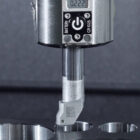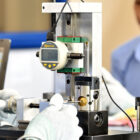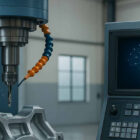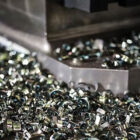For high accuracy interior diameter machining in a variety of industries, boring bars are a necessary tool in precision machining. Their use is widespread, ranging from the automobile to the aerospace industries, where accuracy, dependability, and effectiveness are critical. This blog examines the effective uses of boring bars across several sectors, including the difficulties encountered and the creative solutions put in place to address them.
The automotive industry
Boring bars are used extensively in the automotive industry to machine engine parts such as crankshafts, connecting rods, and cylinders. Precise internal dimensions are necessary for these parts to guarantee the best possible engine performance and fuel economy.
Challenges: The fundamental difficulty in automotive applications is maintaining high production numbers while attaining tight tolerances. In order to satisfy the industry’s strict quality requirements, boring operations need to be carried out extremely precisely. Furthermore, the materials that are utilized present difficulties because of their toughness and tendency to cause tool wear.
Solutions: To overcome these difficulties, advanced boring bars with wear-resistant coatings and improved geometry have been created. For example, the use of polycrystalline diamond (PCD) and cubic boron nitride (CBN) tools has significantly boosted tool life and surface finish. Furthermore, adaptive control systems in conjunction with high-speed machining procedures guarantee that the necessary tolerances are maintained even at high feed rates, increasing production efficiency.
The aerospace industry
Boring bars are essential in the aircraft industry to manufacture parts including fuselage sections, engine parts, and landing gear. The industry requires components with exceptional strength-to-weight ratios, made from materials like titanium and Inconel, which are really difficult to machine.
Challenges: Machining superalloys and composite materials presents difficulties for the aerospace sector. Because of these materials’ extreme cutting resistance, precise tolerances can be difficult to maintain and tools can wear out quickly. Furthermore, boring operations with lengthy overhangs are frequently necessary due to the intricacy of aerospace components, which raises the possibility of vibration and tool deflection.
Solutions: Aerospace manufacturers have embraced high-strength, lightweight materials for their boring bars, which minimize deflection, as a solution to these problems. In order to reduce chatter, vibration-damping technologies have also been included into boring bar designs, such as tuned mass dampers and active vibration control systems. Furthermore, when machining difficult aerospace materials, the utilization of high-pressure coolant systems and cryogenic cooling has improved tool life and surface quality.
The defence industry
Boring bars are required by the defence industry to machine high-performance parts for armament systems, aircraft, and military vehicles. These parts have to live up to high standards for durability and performance.
Challenges: The machining of lightweight, high-strength materials like composites, Inconel, and titanium presents difficulties for the defence industry. For these materials to satisfy the exacting requirements of defence applications, they are challenging to machine and necessitate accuracy.
Solutions: To meet the problems of machining hard materials, defence manufacturers have adapted high-strength materials and optimized geometries for their boring bars. Tool performance and longevity have increased with the application of advanced coatings like titanium aluminium nitride (TiAlN) and diamond-like carbon (DLC). Additionally, to guarantee accuracy and consistency in the machining of defence components, manufacturers use advanced machining processes like adaptive control and real-time monitoring.
The heavy equipment machining industry
Boring bars are essential for the large-scale and high-duty component machining of hydraulic cylinders, axles, and gearboxes in the heavy equipment manufacturing industry. This industry manufactures machinery for use in construction, mining, and agriculture. For heavy machinery to operate dependably, these parts need to be precise.
Challenges: Dealing with significant cutting forces while machining big, heavy components can cause vibration and tool deflection. In addition, it is challenging to obtain the necessary accuracy and surface polish due to the hardness of the material and the size of these components.
Solutions: Boring bars with strong designs and high-tech materials have been utilized by heavy equipment manufacturers to endure high cutting forces during machining. Wear resistance and cutting performance have increased with the introduction of ceramic and carbide inserts. In an effort to increase accuracy even further, manufacturers have integrated real-time monitoring systems that instantly modify the cutting settings, lowering the possibility of tool deflection and guaranteeing reliable outcomes.
The medical industry
Boring bars are used in the medical device industry to machine small, complex parts including implants, prosthetics, and surgical tools. These parts have to be incredibly precise and adhere to strict legal requirements.
Challenges: Requirements for biocompatibility and component miniaturization are obstacles in the medical device industry. High accuracy and surface finish are necessary when machining tiny, complicated pieces made of materials like titanium and stainless steel. In addition, regulatory compliance necessitates maintaining consistent quality over big manufacturing runs.
Solutions: Medical device makers employ micro-boring bars with specific coatings that improve biocompatibility and lower friction in order to overcome these difficulties. Small-scale components with tight tolerances may be produced, thanks to the usage of precision machining centres equipped with cutting-edge control systems. To guarantee constant quality, manufacturers also use automated measuring systems and in-process inspection as quality control techniques.
The oil and gas industry
Boring bars are used in the oil and gas industry to machine large-diameter parts like drilling equipment, pipelines and valves. These parts need to be precise and durable since they have to tolerate high pressures and temperatures.
Challenges: The machining of large-diameter components has several issues, including those pertaining to chip evacuation, heat production, and tool stiffness. Because of their size and scope, even little variations in diameter can have a big impact on how well a component performs in the field. In addition, the hardness and work-hardening propensity of the materials, including stainless steel and duplex alloys, make them difficult to process.
Solutions: In order to overcome these obstacles, the oil and gas industry uses larger-diameter machining-specific geometries and stiffer boring bars. To control heat and enhance chip evacuation, innovations such as internal coolant supply systems have been put into use. Moreover, simultaneous cutting is made possible by the use of multi-insert boring bars, which shortens machining times and guarantees uniform results across the component.
As seen above, boring bars are essential equipment in a variety of industries where precise machining is essential. These industries face unique challenges, but they may be successfully overcome by using cutting-edge coatings, machining methods, and materials to provide dependable performance even in the most trying conditions. It is becoming more and more crucial for boring bar technology to advance as industry demands for accuracy and efficiency rise. At the forefront of these developments is FineTech Toolings, one of the most well-known precision boring bars manufacturers in Bangalore that provides premium solutions to help businesses run more precisely, efficiently, and affordably. Industries can stay ahead of the competition and guarantee the success of their machining operations by making use of these improvements.






